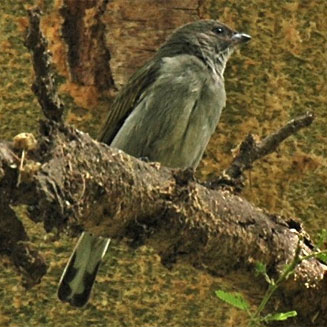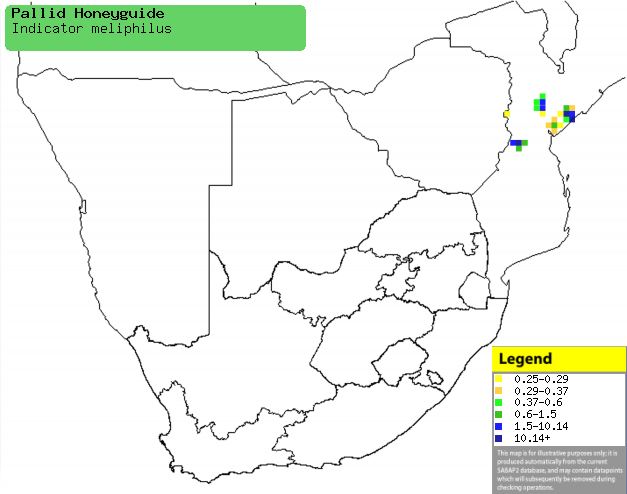|
Indicator meliphilus (Pallid
honeyguide, Eastern honeyguide)
Oostelike heuningwyser [Afrikaans]; Bleke honingspeurder
[Dutch]; Indicateur pāle [French]; Olivmantel-honiganzeiger [German];
Indicador-oriental [Portuguese]
Life
> Eukaryotes >
Opisthokonta
> Metazoa (animals) >
Bilateria >
Deuterostomia > Chordata >
Craniata > Vertebrata (vertebrates) > Gnathostomata (jawed
vertebrates) > Teleostomi (teleost fish) > Osteichthyes (bony fish) > Class:
Sarcopterygii (lobe-finned
fish) > Stegocephalia (terrestrial
vertebrates) > Tetrapoda
(four-legged vertebrates) > Reptiliomorpha > Amniota >
Reptilia (reptiles) >
Romeriida > Diapsida > Archosauromorpha > Archosauria >
Dinosauria
(dinosaurs) > Saurischia > Theropoda (bipedal predatory dinosaurs) >
Coelurosauria > Maniraptora > Aves
(birds) >
Order: Piciformes
> Family: Indicatoridae
 |
|
|
Pallid honeyguide outside of Arusha, northern
Tanzania. [photo
Ken
Clifton ©] |
|
Distribution and habitat
It has two separate populations in Africa; one in Kenya and
Tanzania and the other from Angola to Zambia, Malawi and southern Africa. Within
southern Africa
it is uncommon in central Mozambique and marginally in eastern Zimbabwe It
generally prefers remnant forest, forest edges and secondary regrowth,
occasionally moving into miombo (Brachystegia) and evergreen forest.
|
 |
|
Distribution of Pallid honeyguide in southern Africa,
based on statistical smoothing of the records from first SA Bird Atlas
Project (©
Animal Demography unit, University of
Cape Town; smoothing by Birgit Erni and Francesca Little). Colours range
from dark blue (most common) through to yellow (least common). |
Movements and migrations
Resident and possibly locally nomadic.
Food
Mainly eats insects taken from leaves, flowers and bark,
supplemented with wax from honeycombs of both abandoned or active bees nests.
It often forages like a woodpecker, creeping up a vertical tree trunk and
gleaning prey from bark.
Breeding
- Brood parasite, laying its eggs in other bird nests, such as
White-eared barbets (the
only confirmed host in southern Africa).
- Egg-laying season probably peaks in January.
- Little else is known about its breeding habitats, as they have not been
properly studied.
Threats
Status uncertain, although it is likely to be threatened by
slash-and-burn agriculture and the gathering of firewood.
References
-
Hockey PAR, Dean WRJ and Ryan PG 2005. Roberts
- Birds of southern Africa, VIIth ed. The Trustees of the John Voelcker
Bird Book Fund, Cape Town.
|
